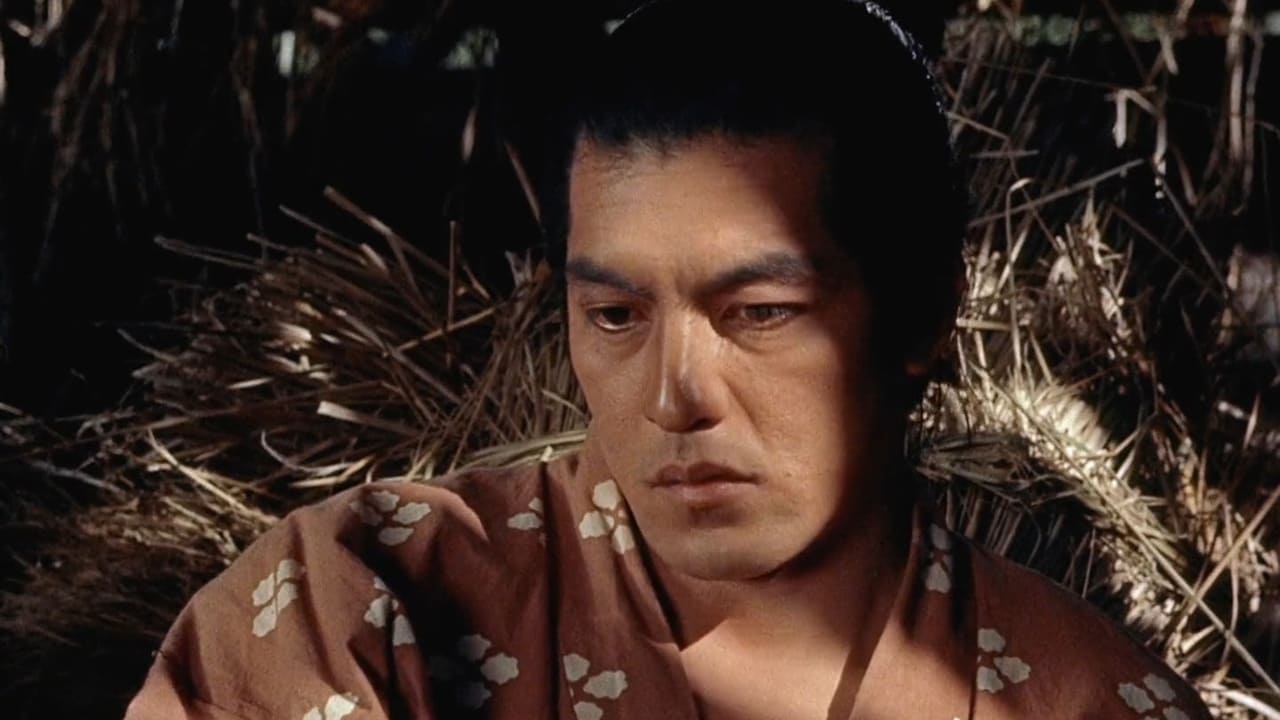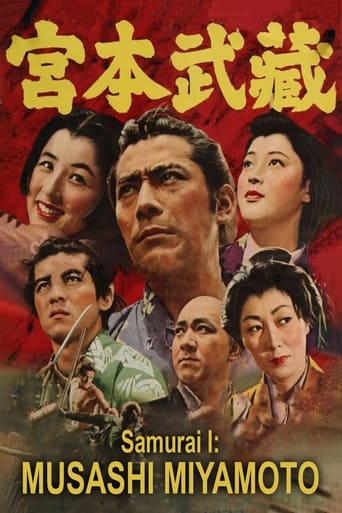

It was OK. I don't see why everyone loves it so much. It wasn't very smart or deep or well-directed.
... View MoreEach character in this movie — down to the smallest one — is an individual rather than a type, prone to spontaneous changes of mood and sometimes amusing outbursts of pettiness or ill humor.
... View MoreThe movie's not perfect, but it sticks the landing of its message. It was engaging - thrilling at times - and I personally thought it was a great time.
... View MoreThrough painfully honest and emotional moments, the movie becomes irresistibly relatable
... View MoreI've finally gotten down to the first in the trilogy of films based on a story that has been touted as the Japanese's equivalent of Gone with the Wind. The Samurai Trilogy, directed by Hiroshi Inagaki, is based on the novel by Eiji Yoshikawa, which tells of the story of the famous samurai Miyamoto Musashi, and an intriguing character who has authored The Book of Five Rings.What more, the titular character is played by the legendary Toshiro Mifune, and that itself is a major treat and a draw for more contemporary audiences. Sadly to say, as with most first films in a series, this one sets out to establish the baseline character of Mushashi, or Takezo as he's better known in his early days, an orphan brought up by relatives and who possesses great strength, but is brash and ill-disciplined. Together with his best friend Honiden Matahachi (Rentaro Mikuni), who had to leave behind his fiancé Otsu (Kaoru Yachigusa), they sign up for war in the hopes of being samurai warriors at the end of battle, only to discover they're fighting on the losing end, and become fugitives.What transpires later involves their flight from the dark, a couple of seduction scenes by a mother-daughter pair of grave-diggers whose fancies for Takezo gets turned toward Honiden, therein splitting the two best friends up, and Takezo being persecuted by his village folk for deserting his best friend since he returned to the village as the sole survivor. But the shrewd monk Takuan (Kuroemon Onoe) sees a diamond in the rough in Takezo, and therefore sets him up to fall under his tutelage, while at the same time Takezo has to decide for himself how to deal with some new found love in Otsu.There's romance, there's battle scenes, there's the obligatory hero who's still unsure of his destiny. By the time the film ends, it leaves you with a lot of subplots still hanging in the air, but I'm crossing my fingers that all these will be addressed in the next two installments. It's a mid 50s film, so fight scenes aren't that polished to perfection. Instead we see Takezo's rather rough and unfanciful swordplay, in part being the gruff character that he is, knowing no finesse in the art of a duel, and also being a foil for realism, where enemies get cut down ruthlessly without wasting time. Technically one should pass over some of the shortcomings such as abrupt camera angle changes, cuts and edits, and it's indeed a pity that the film is not presented in a widescreen format, which would have been quite a spectacle given the vast landscapes that the film was shot in.Perhaps another indication of how dated this period drama is, is in the treatment of the women characters. I guess given socio-unequalness then, the women folk are seen to be terribly in need of a manly figure to be head of their household, and more than willing to be submissive, and obedient, just so to be at the side of their men. It's a far cry from today's world really, where women are far from the weaker sex they are portrayed in the film. Sure a key female character here is as conniving can be, and future installments (I've taken a look at the cast list) seem to demonstrate that there's still more to it all than meets the eye.In short, Samurai I has set the stage, transforming Takezo from nobody, to a ready warrior yet to be tested in the real world. As he sets out for some reality based education, it would prove all the more interesting as he is likely to chance upon old friends and foes, and this time, being skilled and more refined in his ways, would prove to be engaging material for the subsequent films to deal with. Already those two film titles have "Duels" in them, so they should fill for a climatic finale battle each, given the obvious lack of a crescendo this one turned out to be.
... View MoreThe importance of the Miyamo Musashi saga has been lost somewhat today, even in Japan. These were not just early high-quality color samurai movies, not just great films-- they were a nationwide event, and a milestone in Japanese social evolution. The early 50s were a time of postwar healing, and there were unsettled questions about the national character. The Miyamo Musashi saga used the past to dramatize issues of morality-- and, even more important at the time, morale. Japan had no problem westernizing and living under the rule of law under terms imposed by victors in war-- the knotty issue was, how much of the past do we keep alive in our daily thoughts and actions, and just how much of the real Japan, the one we remember, will our children and grandchildren inherit, once the aftermath of global war has subsided? Watch these films with such then-important issues in mind, and your experience will be deepened and enriched. All three episodes are directed by Hiroshi Inagaki and star Toshiro Mifune as Miyamoto-san, in a performance that is perfection. Miyamoto Musashi shows the young samurai aspirant as a hot-headed, imperfect man, neither hero nor monster-- but possessed of a fierce dark force that could impel him toward either outcome. The question of women looms large in this trilogy-- how to treat them, what kind of woman to honor and what kind to avoid, and just how the diametrically-opposite traits of women work in the world, whether at odds or in harmony with those of men. All these issues are played out without preachiness, in the actions of real people, well-drawn characters whom we meet and get to know before the episode ends in a series of parting of ways. (continued on the page for Ichijoji no Ketto)
... View More"Miyamoto Musashi" (1955): by Hiroshi Inagaki, starring Torshiro Mifune. This is an EPIC story of one man who sets out to travel far and wide throughout the land and himself in search of his identity and purpose. It has something of the feel of Herman Hesse's book "Siddhartha", but with Samurai battle scenes (no, it is NOT a silly martial arts film). Having won the Academy Award for Best Foreign Film of 1955, this is 97 minutes of serious life dramas, with the priorities being Japanese, of course. One must think that with less than a decade having passed since Japan's defeat in WWII, this film's considerations (set in the 16th century) - about identity, goals, love, war, status, and true purpose - were nearly unavoidable. Beautiful photography, good color (considering the era), music that occasionally over-swelled the scene, believable sets, and again, a serious story line, make this one worth seeing. This will sound odd, but I found lots of parallels to the early Marlon Brando film, "The Wild One'". Feel free to disagree.
... View MoreThe first of a trilogy that really should be viewed as a whole. This elegant film tells of the very humble beginnings of Miyamoto Mushashi, who has become a paragon of Bushido and Giri. A Samurai's Samurai.However, you have no inkling of this at the beginning of the movie. What we see is dirt and squalor and a desperate chance to get out from beneath the mud. It all goes wrong and things look desperate.As the movie progresses in the slow, methodical, often obtuse, Japanese fashion we become engrossed in the plot and the lives of our protagonists. Toshiro Mifune shows a vast range of emotion, power and character growth in these this movie. To get the full flavour of the story you must also watch the next two movies in this trilogy (2) "Duel at Ichijoji Temple"(1955) (USA)and (3) "Duel on Ganryu Island" (1956)(USA.
... View More